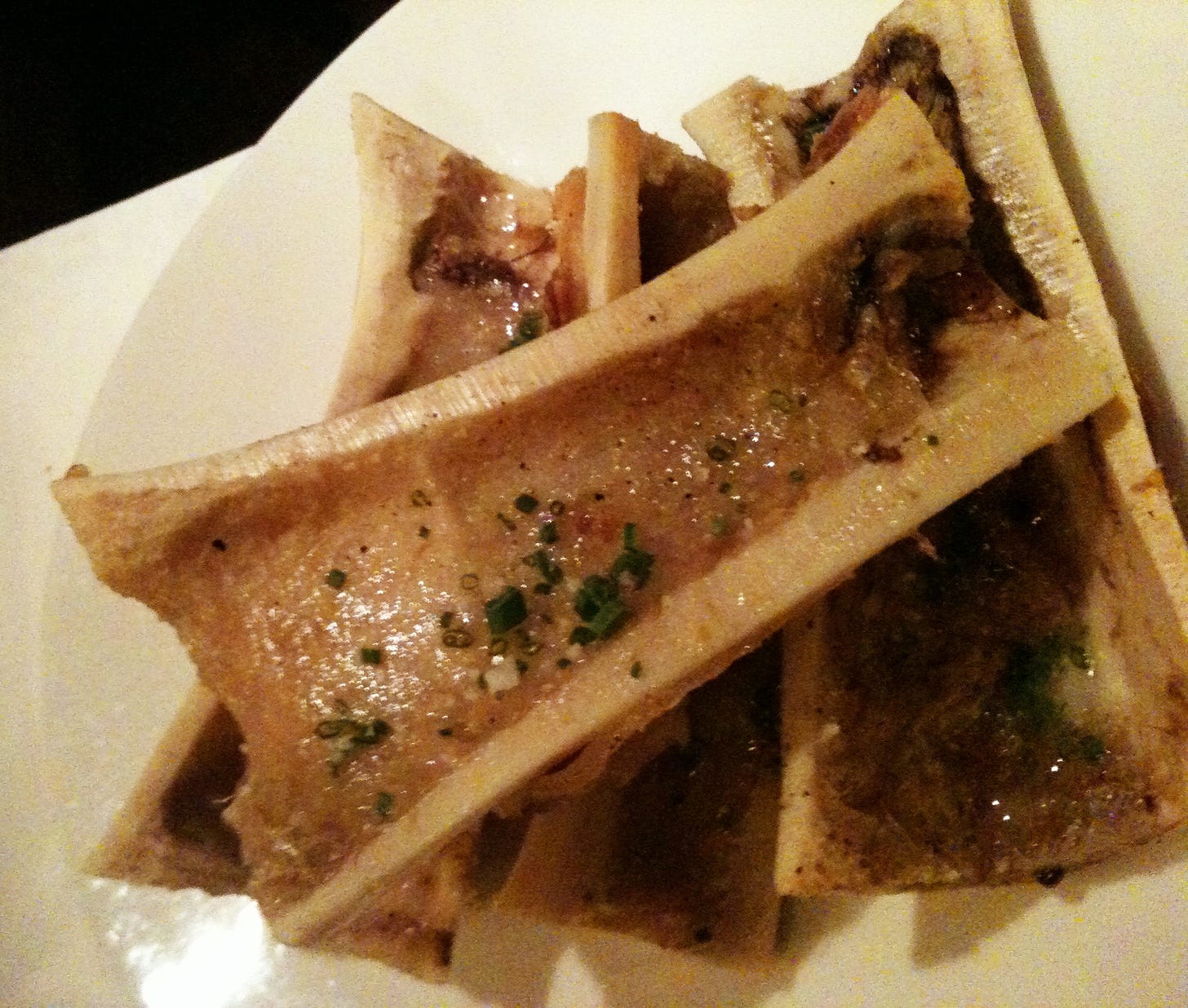Bone Marrow, an overlooked ingredient, makes for some of the more interesting steakhouse dishes. Seasoned chefs learn to understand its value, and have started to take it on the narrow road to Haute Cuisine. Across continents, however, local cooks have used marrow in myriad ways and for centuries, not just to flavor broths, but to anchor dishes that reflect their culture and culinary history.
Let’s look at some of them:
France: Os à Moelle
In French cuisine, bone marrow isn’t a novelty, it’s a building block. Os à Moelle (Roasted Marrow Bones), appear frequently in traditional bistro cooking. The technique is simple: beef bones are cut canoe-style or crosswise and roasted until the marrow becomes molten. It’s served with sea salt, grilled bread, and often a parsley salad with capers or shallot vinaigrette to balance the richness. Beyond stand-alone dishes, marrow is folded into sauces, such as Sauce Bordelaise, where it enriches a red wine and shallot reduction poured over grilled meats.
Italy: Ossobuco alla Milanese
In Milan, bone marrow is the center poece of Ossobuco, a slow-braised veal shank. The bones are cross-cut, allowing the marrow to seep into the braising liquid as it cooks with white wine, aromatics, and sometimes tomato. What’s left is a fork-tender cut of meat and a softened marrow core that’s often spooned out and eaten directly from the bone. Traditionally served with saffron risotto, Ossobuco relies on marrow not just for richness but for mouthfeel and finish.
Mexico: Tuétano
Mexican chefs have created Tuétano for generations. In rural kitchens and street-side taquerías alike, marrow bones are split, roasted, and served with warm corn tortillas, salsa, lime, and fresh herbs. The marrow is scooped onto the tortilla and eaten like a taco. In traditional soups like Caldo de Res, marrow bones are simmered for hours, forming the backbone of the broth. The flavor is unfiltered and comforting.
Vietnam: Phở Bò
Vietnamese Phở isn’t just an iconic national noodle soup, it’s a masterclass in bone broth technique. In Phở Bò, marrow bones simmer gently for up to 12 hours with spices like star anise, clove, and charred ginger and onion. The slow extraction of marrow gives the broth its signature sheen and silkiness. In some Hanoi shops, cooks serve roasted or boiled marrow bones alongside the bowl. Diners are encouraged to scoop the marrow directly onto the noodles or enjoy it with a splash of lime.
Philippines: Bulalo
Bulalo, a beef shank and vegetable soup, is made by simmering large marrow bones with sweet corn, cabbage, potatoes, and onions. The bones infuse the broth with fat and body, while the marrow itself is prized by diners. Bulalo is a communal dish, served hot in big bowls, often shared among family or friends. Eating the marrow is part of the fun, usually done with a spoon.
United Kingdom: Traditional Bone Dishes
British cooking sees marrow in soups and pies. Dishes like Beef Shin and Marrowbone Stew, or Mince and Marrowbone Pie reflect practical, resourceful use of animal parts. In earlier centuries, marrow was also used as a spread, much like butter, on toast. Modern British chefs, into the reviving of nose-to-tail dining, have reintroduced marrow to menus. Fergus Henderson’s roast bone marrow with parsley salad and sourdough became an iconic dish, proving that even in minimal presentation, marrow can deliver maximal flavor.
Indonesia: Sop Buntut
Indonesia oc tail soup, sop buntut, is a familiar way to enjoy marrow-infused broth. While the oxtail meat is the main protein, the bones release collagen and marrow during cooking, creating a broth that is both clear and rich. The seasoning of clove, nutmeg, garlic, and fried shallots balances the marrow’s natural fattiness. Sop buntut is often garnished with a squeeze of lime or a spoonful of sambal. The marrow provides the base note, anchoring the soup in comfort and depth.
Argentina: Asado con Tuétano
In Argentina, bone marrow shows up at the grill. During a traditional Asado (the national barbecue ritual) large beef bones filled with marrow are placed directly on the grill alongside ribs, sausages, and steaks. The marrow bubbles and smokes in its cavity, picking up flavor from the fire. Grillers often serve it simple, with coarse salt and a bit of chimichurri. Diners scoop it onto bread or eat it straight from the bone. In some regions, marrow is even used as a natural basting agent for meats mid-grill to enhance flavor and juiciness.
Brazil: Mocotó and Feijoada
In Brazil, one marrow-rich dish is Mocotó, a stew made from cow’s feet and marrow bones, slow-cooked with beans, vegetables, and sometimes cassava. The gelatin from the bones thickens the broth naturally, and the marrow softens into it, giving the dish its comforting richness. And Feijoada, Brazil’s famous black bean stew, sometimes includes marrow bones along with various pork cuts. Though not always visible in the final dish, the marrow contributes to its complexity, especially when cooked over a low fire for hours.
Image Credit: https://commons.wikimedia.org/w/index.php?curid=131078009
_ _ _
© CHURRASCO PHUKET STEAKHOUSE / ALL RIGHTS RESERVED
Reprinting, reposting & sharing allowed, in exchange for a backlink and credits
Churrasco Phuket Steakhouse serves affordable Wagyu and Black Angus steaks and burgers. We are open daily from 12noon to 11pm at Jungceylon Shopping Center in Patong / Phuket.
We are family-friendly and offer free parking and Wi-Fi for guests. See our menus, reserve your table, find our location, and check all guest reviews here:
https://ChurrascoPhuket.com/
#Churrascophuket #jungceylon #phuketsteakhouse #affordablewagyu #wagyu

